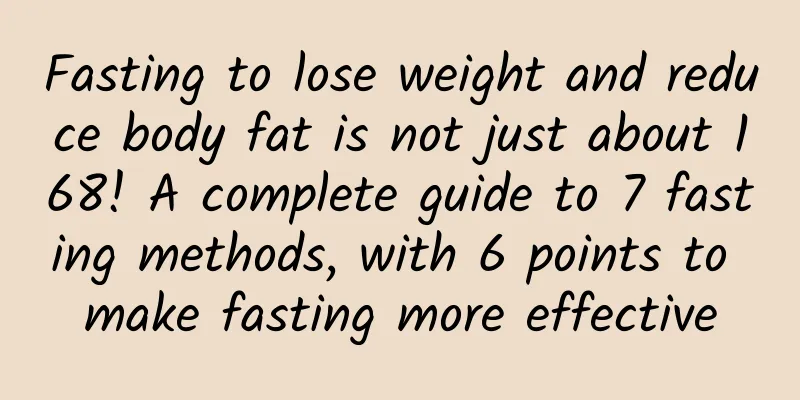Fasting to lose weight and reduce body fat is not just about 168! A complete guide to 7 fasting methods, with 6 points to make fasting more effective

|
There are many different ways to do intermittent fasting, the main differences being the length of time you fast and the amount of calories you consume. Research suggests this diet may lead to benefits such as fat loss, improved health and longer life. More and more people are using fasting methods to achieve the goal of losing weight. Fasting methods such as the 168 fasting method or the 5:2 fasting method are advocated by many nutritionists. The principles of these fasting methods mainly differ in the length of fasting time, and many variations have been derived. However, everyone's physique is different, and the body's adaptability is also different. Before you want to implement a fasting weight loss method, it is best to ask a doctor to evaluate your physical condition and then choose a fasting method that suits your lifestyle! 7 ways to do intermittent fasting: 1. Fast for 12 hours a day The rules of this diet are simple, a person needs to decide on and adhere to a 12-hour fasting period every day. Researchers believe that fasting for 10 to 16 hours causes the body to convert its fat stores into energy, releasing ketones into the bloodstream, which can aid weight loss. This intermittent fasting plan is a good choice for beginners because the fasting periods are relatively short and most of the fasting occurs during sleep. For example, you could choose to fast between 7pm and 7am the next morning, spending most of the time between those hours sleeping. In fact, as long as you keep three meals at fixed times and don't eat extra snacks, basically everyone can easily achieve 12 hours of fasting, which is very helpful for maintaining body shape. 2.168 Fasting Method The most widely known and most widely practiced 168 fasting method is to fast for 16 hours a day and have the remaining 8 hours for eating. The time limit can be adjusted according to each person's living habits. A study in mice found that restricting their eating hours to an eight-hour window also protected them from obesity, inflammation, diabetes, and liver disease, even if they ate the same total number of calories as mice that ate normally. Many celebrities also use the 168 fasting method to maintain their body shape. If 168 fasting is easy for you, you can also shorten the eating time and change to the 186 fasting method, which means fasting for 18 hours and eating for only 6 hours, which can make the weight loss effect more significant. But you can’t just eat whatever you want during mealtimes. You still need to pay attention to your total calorie intake. 3. Fasting two days a week (5:2 fasting method) Maintain a normal diet five days a week and reduce calorie intake the other two days. During the two days of intermittent fasting, it is recommended that men consume 600 calories and women consume 500 calories. The two days of fasting do not need to be consecutive. For example, you can set the fasting days as Monday and Thursday, and eat normally on the other days. Note that there should be at least one non-fasting day between fasting days. Intermittent fasting The 5:2 diet (also known as the fast diet) was proposed by British physician Dr. Mosley. Studies have found that restricting calorie intake twice a week can help with weight loss and significantly improve the incidence of cardiovascular disease, diabetes and cancer, and even generally show better spirits and a happier physical and mental state. 4. Fasting every other day There are many variations of the alternate-day fasting plan, but the principle is to fast every other day. Some people avoid solid food completely on their fasting days, while others allow up to 500 calories. However, on normal eating days, there are no restrictions on food and calorie intake. Alternate-day fasting is effective for adults who want to lose weight and take care of their heart health, a study reports. The 32 participants lost an average of 5.2 kg over the 12-week period. Alternate-day fasting is an extreme form of intermittent fasting. It may not be suitable for beginners or people with certain medical conditions. It is also difficult to maintain this type of fasting in the long run. It can be practiced occasionally when you want to detoxify and cleanse your intestines. 5. Fast completely 1-2 days a week Completely fast for 1 or 2 days once a week, the so-called "eat-stop-eat" diet, up to 24 hours without food. Water, tea, and other calorie-free beverages are acceptable while on this diet. Fasting for 24 hours can be challenging and may cause fatigue, headaches, or irritability. However, many people report that these effects gradually diminish over time as their bodies adjust to this new way of eating, and they eventually feel a sense of lightness and freedom. It is best to proceed step by step, starting with a short fast and then trying a full day of fasting once your body has adapted. 6. Reduce one-meal fasting This flexible intermittent fasting method is more suitable for beginners, mainly for occasionally skipping meals. People can decide whether to eat or not based on their hunger levels or time constraints, but it is important to eat healthy foods at every meal. For people who can correctly judge whether they need to replenish energy, skipping meals may be the most successful and easiest to implement. Basically, the principle of this intermittent fasting method is to eat when you feel hungry and not eat when you are not hungry. 7. Warrior Diet 20:4 Fasting The Warrior Diet is a relatively extreme form of intermittent fasting. The warrior diet has a fasting period of 20 hours, and the eating time is only 4 hours. It is also recommended to eat clean original food as much as possible and pay attention to balanced nutrition. The average person doesn't need to go to such extremes, and it's usually recommended for athletes or people who train a lot. Supporters of the 20:4 fasting method believe that humans are natural night eaters and that eating at night allows the body to obtain nutrition that is consistent with the circadian rhythm. During the 4-hour eating window, make sure to eat plenty of vegetables, protein, and healthy fats, and include some carbohydrates as well. Although there are brief 4-hour windows during the day when some food can be consumed, it is challenging to stick to the strict guidelines of what to eat over the long term. 6 Ways to Make Intermittent Fasting More Effective Drink enough water. Drink plenty of water and calorie-free beverages throughout the day, such as unsweetened tea and black coffee, but do not drink unsweetened soy milk. Avoid obsessing over food. During your fasting time, you can schedule distractions to keep you from thinking about food, such as working or watching a movie. Rest and relaxation. Avoid strenuous exercise while fasting, but light exercise such as yoga can still be performed as usual. Count calories. If you want to lose weight more effectively, you still need to pay attention to your calorie intake. When eating, remember to choose nutritious foods rich in protein, fiber and healthy fats, including beans, eggs, fish, nuts and avocados. Add flavor to food. Season your food generously with garlic, herbs, spices or vinegar, which are very low in calories and may help reduce hunger. Choose nutrient-dense, low GI foods. Eating foods high in fiber, vitamins, minerals, and other nutrients can help keep blood sugar levels stable and prevent nutrient deficiencies. A balanced diet can also aid in weight loss and overall health. There are many different ways to do intermittent fasting, and no single plan works for everyone. It is recommended that you try multiple methods to implement it in the way that best suits your lifestyle. If you don't see any results after fasting, pay special attention to whether your calorie intake during eating exceeds your basal metabolic rate, and extend the duration of fasting. It is recommended that you evaluate the results after a month of fasting, and don't be impatient to lose weight in two days. ※This article is authorized by VOGUE magazine and is prohibited from being reproduced without permission. (For the full article, please visit VOGUE.com) Experiments have found the 8 best foods for weight loss Boost your immunity by doing this! 10 ways to develop health that you can do every day "Only eat until you are 60% full and only eat fruit in the morning." Tiffany Hsu shares the [key secret] for maintaining a good figure Slimming belly and waist exercise: One-legged dog pose variation, one-legged kneeling twist pose, 2 moves in series, yoga to slim belly and train abdominal muscles, very effective For more exciting reports, please visit VOGUE website ※This article is authorized by VOGUE magazine and is prohibited from being reproduced without permission. |
Recommend
Different types of pelvic inflammatory disease are treated differently
Pelvic inflammatory disease is mainly divided int...
Methods of natural abortion
Spontaneous miscarriage refers to the spontaneous...
What foods are suitable for patients with cervical warts?
Cervical warts are difficult to treat nowadays. W...
Three ways to check for uterine fibroids
Uterine fibroids are a relatively common benign g...
How to avoid endometrial tuberculosis during pregnancy
It is necessary for female friends to understand ...
What is the cause of itching under cervical erosion?
Cervical erosion refers to cervical columnar epit...
Which one is less harmful to the body, medical abortion or surgical abortion
Medical abortion and surgical abortion are genera...
A brief analysis of common precautions for the treatment of vulvar leukoplakia
The precautions for treating vulvar leukoplakia a...
What to do if there is uterine fluid during pregnancy
What should I do if there is uterine fluid accumu...
Is there still leucorrhea after menopause at the age of 50?
Whether there is still leucorrhea after menopause...
Symptoms of ectopic pregnancy vary from patient to patient
Ectopic pregnancy is mainly divided into two type...
What medicines are used to treat cervicitis in women? It is recommended to use these medicines to treat cervicitis.
Patients with cervicitis usually experience exter...
The most important things to note after abortion
Abortion is a common phenomenon in today's so...
Early symptoms of cervicitis
Experts from our hospital said that early detecti...
What are the Chinese patent medicines for patients with cervical precancerous lesions?
Cervical precancerous lesions are one of the fema...









